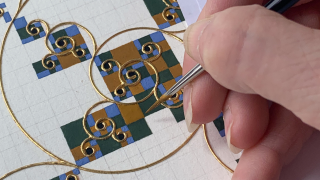



Approximating the Harriss Spiral with whirling squares
Lemon gold on raised gesso, handmade gum tempera and shell gold on cotton rag watercolour paper
58.5 x 43.5 cm
Artist statement
Illuminating Curves
I have long had a fascination for the intrinsic artistry expressed when mathematics are visualised, and have always been intrigued by patterns-making and the joy of algorithmic art, both the making and viewing. One area of particular interest is the use of diapering in the decorative arts. It has been employed through the ages in medieval stained glass, heraldry and, especially for my interest, European miniature painting. Here, it was used to decorate backgrounds in order to develop visual interest with the repetition of simple elements.
My exploration of mathematical art has introduced me to the inherent beauty of fractal curves where the iteration of simple steps results in the emergence of complex patterns that exhibit self-similarity at different scales and mesmerise the viewer with their intricacy. For me these curves, emerging from the pure mathematical aspect of their geometry, offer a glimpse into the mystery of creation behind the veil of our mundane reality. The aim with my 2nd year project is to use the techniques of manuscript illumination to convey and celebrate this sacred aspect of number.
My first piece, a painting using illumination techniques, is inspired by the work of Edmund Harriss (British mathematician born 1976) and the Harriss Spiral. Most people are familiar with the golden rectangle and the spiral that can be constructed in it, but this is only one example of a more general idea of how a rectangle can be divided into squares and rectangles. The solutions in all cases are algebraic and the golden ratio is just one of them. By applying this method of division to other proportional rectangles, Harriss arrived at his ‘proportion systems’ and discovered a new fractal spiral that now bears his name.
Further pieces in this series will explore other mathematical curves, for example, the Fibonacci Snowflake, a closed curve based on the Fibonacci sequence. This can be used for tiling the whole plane with translated copies of it. Another example is the Heighway Dragon Curve, one of a whole family of self-similar fractal curves, many of which have been approximated by recursive methods such as the Lindenmayer systems, interesting systems which are used to describe the behaviour of plant cells.
Biography

Rachel Kaufmann has a background in paper and book conservation that continually informs her practice, providing a foundation for a holistic and traditionally rooted approach to realising art on paper. A second degree in book arts guided her interest in applying her study of the arts of the book to her own artistic expression.
A key principle of Rachel’s work is her understanding of the qualities and sensitivities of paper together with the chemistry and properties of pigments and the paints made with them. She brings this understanding, enhanced with the subtleties of application and the nuances of different tools, to produce figurative and geometric paintings which themselves, in their imagery and composition, explore the physics and the intrinsic links with the mathematics of the natural world. When all these elements are combined the result has the effect of harmonics in music — they resonate with each other producing a subliminal satisfaction that the conscious mind would be hard-pressed to define.
The quality of technique has been a thread running through all of Rachel’s learning processes. Attention to detail allows a chosen image to develop its own ‘soul’, it takes it beyond manual manipulation to a place where it surprises and opens out its own vistas allowing the piece to be appreciated from different stand-points.
A period in Rajasthan learning miniature painting inspired Rachel to pursue a Master’s Degree at The Prince’s School of Traditional Arts where she has refined her interest in the forms, materials and techniques of European, Persian and Indian book arts. Her focus now is on developing her own material and visual palette, applying what she has learned from these sister traditions to a more personal imagery without compromising the integral beauty and spiritual meaning that they embody.
Contact
Website:
https://www.filosoficaljunky.art/
Email: rae[at]filosoficaljunky.art




